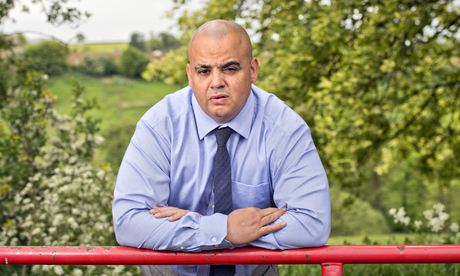
Teacher Marvin Grubb woke one morning with a pain in his neck. Hours later, the right side of his face had collapsed, leaving him unable to close one eye or use the right side of his mouth. He rushed to hospital fearing a stroke, but was eventually diagnosed with Bell's palsy.
"I was unable to drink, struggled to eat, and had to tape my eye down when I went to sleep. It was a very cold winter and my eyeball froze in my skull. I'd watch my son play football and the wind would blow directly into the eye, because you lose the blink reflex. You don't realise how much you use it until it is gone."
While facial palsy – a weakness of the muscles in the face caused by nerve damage – can be physically debilitating, the emotional blow is often harder to bounce back from. Losing the ability to express positive emotions such as joy, love and kindness, or being unable to greet a friend or loved one with a welcoming grin can be devastating
Grubb, 41, a decorated Gulf war veteran, has learned to live with his new face. Others, though, are still struggling to come to terms with what he describes as a "visual hell". Friends frightened by his deformity have stopped talking to him, strangers unable to read visual cues stare in horror and even his girlfriend has nicknamed his crooked profile his "mean side".
For two months, he struggled to speak without lifting his face with one hand, and he still fights to find the words to describe the impact facial palsy has had on his confidence and self-esteem. "There is nowhere to hide," he says. "Everyone can see it on your face and you can't cover it up."
There are at least 30 different known causes of facial palsy, from tumours to head trauma. Bell's palsy is the most common and is a condition whereby the inner ear becomes inflamed, resulting in pressure on the facial nerve. This, in turn, causes facial paralysis on the affected side. It can strike anyone, at any time.
Kelly Lynskey, though, was born with the nerve damage and has never seen herself with a "normal" smile. She says she used to hold a mirror to her face to reflect her good side and see what a full smile would look like. Like many with the condition, Lynskey, now 40, feels self-conscious and embarrassed about how her mouth turns up on one side when she tries to smile, and avoids being photographed.
She explains that, even though her demeanour is generally happy, strangers find it hard to read her facial expressions. "Because I grew up with the condition, I am aware of my facial palsy every day," says Lynskey. "So if I meet someone different, I am always bubbly and try to not make people notice. Instead, I try to make jokes to take the focus off my face. It does hurt when people make comments but I'd rather laugh with them than be laughed at."
Years of bullying at school took their toll though and, at the age of 15, she decided to undergo surgery to bring movement back to her face. But the procedure – which involved grafting muscle and nerves from another part of her body on to the affected side of her face – failed to give her the smile she longed for. After another unsuccessful attempt, the doctors discharged her and she was left to cope with the condition, leaving her feeling isolated and alone. Only with the help of online support group Courage to Smile has she found the confidence to search again for surgical solutions.
Lynskey's feeling of abandonment by the health system is not an isolated case. Ignorance among GPs about the condition and treatment for facial palsy continues to be a major concern. That is despite treatment such as physiotherapy, or even Botox, which have been shown to make a real difference to a patient's quality of life. Some of these treatments are denied on the NHS because they are deemed to be cosmetic.
A study published in the British Medical Journal last year revealed that almost half of patients with facial paralysis are not receiving the recommended treatment that could prevent permanent disability. The charity Facial Palsy UK, which supports people affected by facial paralysis, says vast improvements are needed in the treatment of Bell's palsy.
The research looked at how people diagnosed with Bell's palsy between the years 2001 and 2012 were managed by GPs. It showed that despite clear evidence that the steroid prednisolone improves the chances of complete recovery, 44% of patients were not given any treatment.
Dr Charles Nduka, the founder of Facial Palsy UK, says faster access to care to minimise complications is needed, as well as specialist centres with a multidisciplinary approach to manage the range of symptoms. One of the difficulties in furthering our understanding of facial palsy, however, is that it is a slowly evolving condition, so any research to investigate preventions or interventions requires a long time.
But progress, no matter how small, can transform lives. Emma Barrett lost the ability to move the right side of her face when she was 18 after an operation to remove a tumour on her hearing nerve. After a decade of surgery, she is finally beginning to regain control of her face. Coming to terms with her smile coming back has been almost harder than losing it. "I've spent most of life without it, so to have it back now is very strange," she says.
"I see myself before 18 and after as two separate people. I didn't start truly being me until the facial palsy happened. It has made me who I am – hard, tough and frank. It has given me courage and strength."

